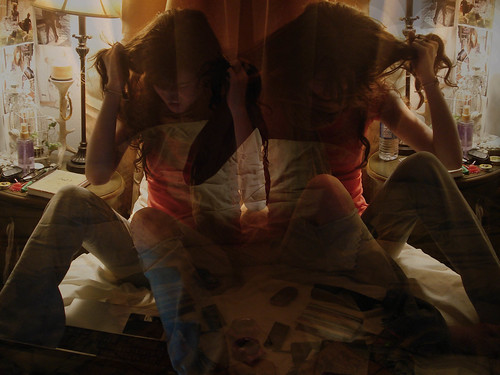For anyone who may not have heard of hair pulling in humans, here is what it breaks down to:
1. the hand is raised to the head
2. a hair of a satisfying texture is sought out - usually from the crown area
3. the hair is plucked out
4. the hair is examined, particularly the white root attached (not to get a root is a failure!)
5. the root is rubbed against the lips and sometimes licked
6. the hair root is combed off using the front teeth or simply bitten off
7. the root is eaten
8. the spent hair is discarded
This process can continue – depending on whether it’s interrupted or not – for hours at a time!
One of the predictable consequences of hair pulling is hair thinning and even baldness in those favoured areas of the scalp where pulling takes place. It can be a source of great embarrassment and awkwardness and for this reason pullers and psychologists tend to overfocus on symptoms of hair pulling rather than examining its root causes (no pun intended). This can mean people wearing hats, using hairnets, putting on gloves or keeping their mouths busy with gum, among other barrier techniques. But to me, this response misses the mark and what’s more these methods are rarely effective.
The point is that people are pulling their hair out because it is satisfying in some way – it makes them feel good! There are a number of reasons this may be the case:
a. yanking out a hair can be painful, but like all painful activities after a while (think of jogging or extreme physical exertion) endorphins are released and these raise the pain threshold.
1. the hand is raised to the head
2. a hair of a satisfying texture is sought out - usually from the crown area
3. the hair is plucked out
4. the hair is examined, particularly the white root attached (not to get a root is a failure!)
5. the root is rubbed against the lips and sometimes licked
6. the hair root is combed off using the front teeth or simply bitten off
7. the root is eaten
8. the spent hair is discarded
This process can continue – depending on whether it’s interrupted or not – for hours at a time!
One of the predictable consequences of hair pulling is hair thinning and even baldness in those favoured areas of the scalp where pulling takes place. It can be a source of great embarrassment and awkwardness and for this reason pullers and psychologists tend to overfocus on symptoms of hair pulling rather than examining its root causes (no pun intended). This can mean people wearing hats, using hairnets, putting on gloves or keeping their mouths busy with gum, among other barrier techniques. But to me, this response misses the mark and what’s more these methods are rarely effective.
The point is that people are pulling their hair out because it is satisfying in some way – it makes them feel good! There are a number of reasons this may be the case:
a. yanking out a hair can be painful, but like all painful activities after a while (think of jogging or extreme physical exertion) endorphins are released and these raise the pain threshold.
b. The act of rubbing, licking and removing the hair root involves a lot of oral manipulation which may increase saliva production. If you can imagine anticipating your favourite food when saliva production occurs then you can get something of an idea as to why the 'tasty' lipid fat root is so prized. It is also made of fat and fat is something that humans tend to enjoy.
My take on hair pulling is that is has homeostatic benefits - which means that the activity helps the person regulate their internal physiological state in some way. There has not been too much experimentation on this unfortunately. (Partly because it can be hard to find subjects who hair pull to participate.) But it would be interesting to find out:
i. are endorphins released which reduce the effects of pain?
ii. do cortisol levels (i.e. stress levels) decrease during hair pulling bouts?
iii. are there any other hormonal changes related to hair pulling, such as oxytocin release?
The other thing I would like to find out relates to the title of this blog page – is hair pulling a displacement behaviour.? In other words, do people do it because a motivation or behaviour has otherwise been thwarted. For example, thwarted attachment seeking (or grooming) due to a neglectful or rejecting parent may precipitate this form of self-grooming. In this situation, a desire to approach or achieve comfort is constantly sought as an internal state but in an environment in which it cannot be satisfied. This kind of mismatch, if occurring for a prolonged period and during a sensitive phase of development, may bring on hair pulling. The final thing to mention is that the 8 stages above are so commonly observed in people who are hair pullers that it cannot be written off as an idiosyncratic behaviour that a few people coincidentally share. Instead it can be viewed as a species specific behavioural program that emerges under conditions of prolonged frustration - and it also affects animals in captivity too. So, the plot thickens….

No comments:
Post a Comment
Please leave your comment below: